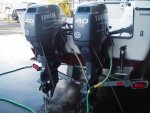Before going further into the issues, I would at least do what Pedro suggested. Cleaning engine passages does not necessarily require a tear down of the engine.
Rydlyme, white vinegar, or dilute hydrochloric acid are also good "salt" removers. The "salt" may also be a calcium carbonate salt, not just sodium or calcium chloride. You can run the engine, at an idle, with a 5 to 7 gallon bucket of water, with dilute acid. Watch the engine temp.
Have the engines been run in salt water without flushing? How did the passage near the thermostat look?
I bought a boat which had an overheat problem, and running it for some time at idle with dilute acid (like Rydlyme) solved the issue. It did not recur, since I flushed my engine after each salt water use (the exception being when cruising multiple days) Even then you can periodically put salt away solution thru the passages.
Try this before even considering tearing down the engine. Also get your cheap IR thermometer out and with the cowl off take spot readings on the engine block. Mark and chart the places you measured the temperature at. Then after flushing/running with the acid, re-measure the temps.
Right now, before you do anything, run both engines on the flusher (with the thermostat in), and measure the same places with the IR thermometer.
You are not going to run the engine at more than a fast idle, but you also want to know the temps at this speed, since the thermostat should open up during a fast idle.
Now a question--how often are you running the engine over 5,000 RPM?
I would take the boat out, and run up to the temp where the alarm is going off, (cowl off) and see what the temp readings are.) (don't shut down the engines, but drop to an idle--you want to keep cooling water flowing, even with an alarm--shutting down the engine does more harm.
Even the thermostat alone causes some restriction of water flow. That is why you are still getting alarms with the good thermostat in. So....not a good idea to run with no thermostat, do the impeller and housing,


